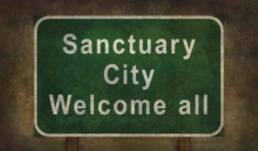On January 25, 2017 President Trump issued an executive order titled, “ENHANCING PUBLIC SAFETY IN THE INTERIOR OF THE UNITED STATES.” Section 9 of that order, which directed the Attorney General and the Secretary of the Department of Homeland Security to withhold federal funds from “sanctuary cities,” was blocked by District Court Judge William H. Orrick on April 25, 2017.
So what exactly is a “sanctuary city”? The term itself does not have a precise legal definition, but it is commonly understood as any city which limits its cooperation with the federal government’s effort in enforcing immigration law. The leaders of these sanctuary cities want to reduce the fear of deportation and family break-ups among individuals illegally present in the United States. So what they do is enact policies, either expressly or in practice, that reduce an individual’s risk of being exposed as an illegal alien. This ranges from prohibiting police questioning about an individual’s immigration status to refusing requests by federal immigration authorities to detain individuals beyond their release date. The idea is that by reducing the fear of immigration enforcement, individuals will be more willing to report crimes, enroll their children in school, and use health and social services.
More about the Court’s ruling. It was announced on April 25, 2017 that President Trump’s attempt to withhold federal funds from sanctuary cities would be temporarily blocked. The executive order itself was not deemed unconstitutional, but the District Court hinted at that possibility in the future. The judge stated that President Trump overstepped his power by tying billions of dollars in federal funding to immigration enforcement. Federal spending power is entrusted in the legislature, and Judge Orrick stated that only Congress could place conditions on federal grants. The central focus of debate was the uncertainty surrounding what exactly constitutes a “sanctuary jurisdiction,” and what federal funds would be taken away. The plaintiffs, San Francisco and Santa Clara County, argued that the policy would cost them billions of dollars in federal funding, while the government’s argument hinged on a much narrower interpretation of the executive order. The government stated that the order would only apply to jurisdictions that refused to share citizenship information with federal authorities, and that it would only apply to three federal grants. The District Court ultimately sided with the plaintiffs who had demonstrated the likelihood of “immediate irreparable harm” if the policy were to be put in place.
This marks the third immigration order blocked by federal courts in President Trump’s first 100 days in office. Similar to the first two, the Court looked at the President’s own rhetoric for guidance. The judge used specific statements by the President and the Attorney General against the government’s lawyers. The President has been quoted as referring to the order as a “weapon,” and that he intends to use it against jurisdictions that disagree with the administration’s immigration policies. These statements contradicted the new, narrow interpretation of the order, and the judge stated that “if there was doubt about the scope of the order, the President and Attorney General have erased it with their public comments.”
Berardi Immigration Law is committed to providing our clients with the most up-to-date and accurate immigration news. Be sure to check our blog for more updates!
Ready to have Berardi on your side?
Whether you’re a business looking to hire or a professional hoping to relocate, immigration law can be complicated. But you don’t have to do it alone. Put our experience to work for you.



